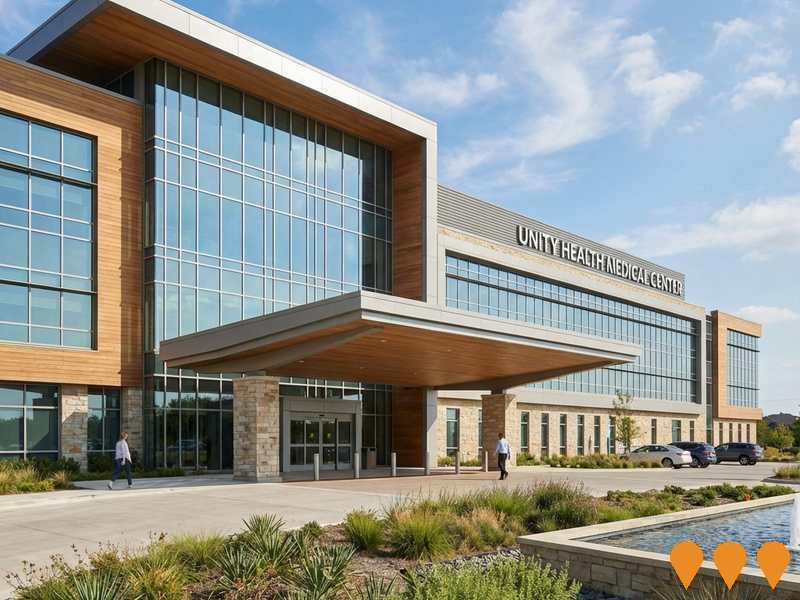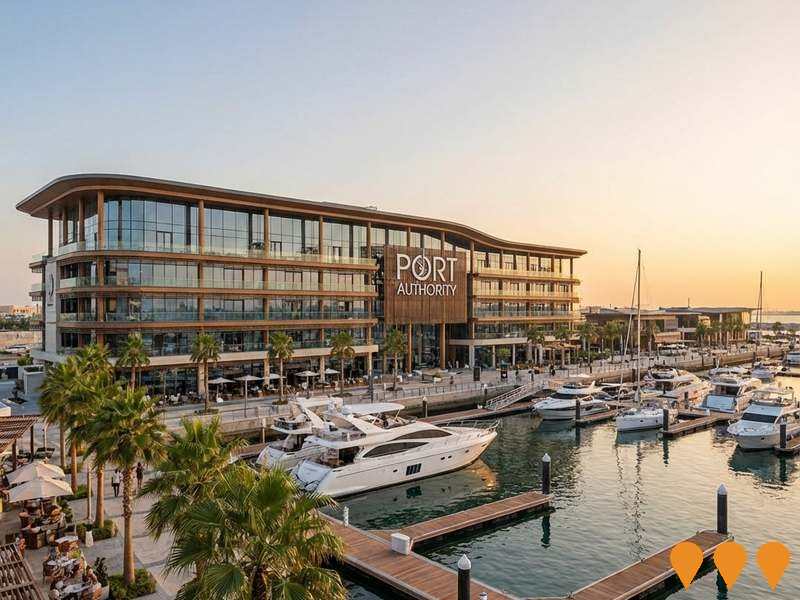Chart Color Schemes
est. as @ -- *
ABS ERP | -- people | --
2021 Census | -- people
Sales Activity
Curious about local property values? Filter the chart to assess the volume and appreciation (including resales) trends and regional comparisons, or scroll to the map below view this information at an individual property level.
Find a Recent Sale
Sales Detail
Population
Currumbin Waters has seen population growth performance typically on par with national averages when looking at short and medium term trends
Based on AreaSearch's analysis, Currumbin Waters' population is around 10,206 as of Aug 2025. This reflects an increase of 409 people since the 2021 Census, which reported a population of 9,797 people. The change is inferred from the estimated resident population of 10,183 from the ABS as of June 2024 and an additional 19 validated new addresses since the Census date. This level of population equates to a density ratio of 1,034 persons per square kilometer. Population growth was primarily driven by overseas migration, contributing approximately 78.1% of overall population gains during recent periods.
AreaSearch is adopting ABS/Geoscience Australia projections for each SA2 area, released in 2024 with a base year of 2022. For areas not covered and years post-2032, Queensland State Government's SA2 area projections are adopted, released in 2023 based on 2021 data. These state projections do not provide age category splits; hence proportional growth weightings from ABS Greater Capital Region projections (released in 2023, based on 2022 data) are applied where utilised. Demographic trends indicate a population increase just below the median of Australian non-metropolitan areas by Aug 2041, with an expected expansion of 631 persons from the latest population numbers, recording a gain of 6.0% over the 17 years.
Frequently Asked Questions - Population
Development
Residential development activity is lower than average in Currumbin Waters according to AreaSearch's national comparison of local real estate markets
Currumbin Waters has averaged approximately 11 new dwelling approvals annually over the past five financial years, totalling 56 homes. As of FY26, 4 approvals have been recorded. On average, around 6.5 people per year have moved to the area for each dwelling built between FY21 and FY25. This significant demand exceeds new supply, typically leading to price growth and increased buyer competition.
The average construction value of new properties is $1,036,000, indicating developers target the premium market segment with higher-end properties. In FY26, there have been $7.8 million in commercial approvals, suggesting the area's residential character. Compared to the Rest of Qld, Currumbin Waters shows substantially reduced construction (89.0% below regional average per person), supporting stronger demand and values for established properties. This activity is also under the national average, indicating the area's established nature and potential planning limitations. New development consists of 89.0% detached houses and 11.0% attached dwellings, sustaining the area's suburban identity with a concentration of family homes suited to buyers seeking space.
Notably, developers are constructing more detached housing than the existing pattern implies (71.0% at Census), reflecting persistent strong demand for family homes despite densification trends. The location has approximately 1066 people per dwelling approval, demonstrating an established market. Population forecasts indicate Currumbin Waters will gain 608 residents by 2041. If current construction levels persist, housing supply may lag population growth, likely intensifying buyer competition and underpinning price growth.
Frequently Asked Questions - Development
Infrastructure
Currumbin Waters has moderate levels of nearby infrastructure activity, ranking in the top 50% nationally
Changes to local infrastructure significantly impact an area's performance. AreaSearch has identified 25 projects that could affect the region. Notable initiatives include Central Park Residences, GemLife Currumbin Waters, Currumbin Creek Road-Bienvenue Drive Intersection Upgrade, and Currumbin Service and Retail Centre. The following list details projects most likely to be relevant.
Professional plan users can use the search below to filter and access additional projects.
INFRASTRUCTURE SEARCH
 Denotes AI-based impression for illustrative purposes only, not to be taken as definitive under any circumstances. Please follow links and conduct other investigations from the project's source for actual imagery. Developers and project owners wishing us to use original imagery please Contact Us and we will do so.
Denotes AI-based impression for illustrative purposes only, not to be taken as definitive under any circumstances. Please follow links and conduct other investigations from the project's source for actual imagery. Developers and project owners wishing us to use original imagery please Contact Us and we will do so.
Frequently Asked Questions - Infrastructure
Gold Coast Heavy Rail Extension - Varsity Lakes to Gold Coast Airport
Long-term planning to extend the Gold Coast heavy rail line south from Varsity Lakes to Gold Coast Airport via new stations at Tallebudgera, Elanora/Palm Beach, Tugun and the airport terminal. The 13 km corridor has been protected since 2008. The project is reaffirmed in ShapingSEQ 2023 and SEQ Rail Connect (2032 Olympic legacy plan) as a future priority, but remains unfunded with no committed construction start date or detailed business case released as of December 2025.

Currumbin Service and Retail Centre
A mixed-use warehouse style retail development on 4.5ha of land, offering fuel, fast food, health, fitness, and storage facilities for the local community and travellers, accessible from the M1 Highway at the Stewart Road interchange.

Currumbin Service and Retail Centre
Completed mixed-use retail and service centre on a 4.5 ha site at the M1/Stewart Road interchange, anchored by a service station and quick service food outlets, with large format retail, gym and multi-level self storage. Opened in 2023 and largely leased, it serves local residents and motorway traffic.

Palm Beach Oceanway Extension
Extension of the beachfront cycling and walking path along Palm Beach, connecting to existing infrastructure to promote active transport and recreation. The project includes new pathways, lighting, and amenities to enhance community access.

Elanora Childcare Centre Development Site
Proposed 51-place dual-level childcare facility development on a 755 sqm site adjoining Elanora State School. The site presents an investment opportunity in a high-demand childcare catchment area with strong demographics and proximity to The Pines Shopping Centre.

Admiral Crescent Residential Care and Retirement Facility
Approved development for a residential care facility and retirement village with 154 suites on a 1.48ha site zoned for medium density residential, located opposite John Flynn Hospital. The site was recently sold on May 2, 2025, with development approval in place.

Ellandra Reserve Estate
An exclusive gated community development featuring 105 townhouse dwellings on a 10.98-hectare site in a joint venture between Neumann Developments and Ritz Group. The project is designed to complement surrounding natural bushland and includes significant rehabilitated environmental open space that will be handed back to Council, forming part of the koala habitat corridor. The development seeks a new Development Permit with community spaces and considers topographical challenges while minimizing environmental impacts.

Central Park Residences
A sustainable residential development offering 150 luxury townhomes and skyhomes with energy-efficient features like solar panels and EV-ready infrastructure, premium finishes, and spacious layouts for families and downsizers near Currumbin Beach.

Employment
Employment conditions in Currumbin Waters demonstrate strong performance, ranking among the top 35% of areas assessed nationally
Currumbin Waters has a skilled workforce with notable representation in essential services sectors. The unemployment rate was 2.8% as of June 2025.
Employment growth over the past year was estimated at 2.4%. As of June 2025, 5301 residents were employed, with an unemployment rate of 1.1% below Rest of Qld's rate of 3.9%. Workforce participation was 61.4%, slightly higher than Rest of Qld's 59.1%. Employment is concentrated in health care & social assistance, construction, and retail trade.
Currumbin Waters has a particular employment specialization in construction, with an employment share 1.5 times the regional level. Conversely, agriculture, forestry & fishing employs only 0.2% of local workers, below Rest of Qld's 4.5%. Over the 12 months to June 2025, employment increased by 2.4%, while labour force grew by 2.0%, causing a fall in unemployment rate by 0.3 percentage points. This contrasts with Rest of Qld where employment rose by 1.8%, labour force grew by 2.0%, and unemployment rose by 0.2 percentage points. Jobs and Skills Australia's national employment forecasts from May 2025 suggest potential future demand within Currumbin Waters. These projections estimate national employment growth at 6.6% over five years and 13.7% over ten years, with varying rates across industry sectors. Applying these projections to Currumbin Waters' employment mix suggests local growth of approximately 6.7% over five years and 13.7% over ten years, though this is a simple extrapolation for illustrative purposes only.
Frequently Asked Questions - Employment
Income
The area's income profile falls below national averages based on AreaSearch analysis
According to AreaSearch's aggregation of the latest postcode level ATO data released on June 30, 2022, Currumbin Waters had a median income among taxpayers of $50,117 with the average level standing at $71,710. Nationally, these figures are high compared to levels of $50,780 and $64,844 across Rest of Qld respectively. Based on Wage Price Index growth of 13.99% since financial year 2022, current estimates would be approximately $57,128 (median) and $81,742 (average) as of September 2025. Census data reveals household income ranks at the 38th percentile, family income at the 40th percentile, and personal income at the 44th percentile in Currumbin Waters. Distribution data shows that 31.5% of individuals earn between $1,500 - 2,999 annually, with 3,214 people falling into this category. This is consistent with broader trends across the region showing 31.7% in the same earnings band. Housing affordability pressures are severe in Currumbin Waters, with only 81.1% of income remaining after housing costs, ranking at the 41st percentile. The area's SEIFA income ranking places it in the 5th decile.
Frequently Asked Questions - Income
Housing
Currumbin Waters is characterized by a predominantly suburban housing profile, with above-average rates of outright home ownership
Currumbin Waters' dwelling structure, as per the latest Census, consisted of 71.4% houses and 28.6% other dwellings (semi-detached, apartments, 'other' dwellings). This contrasts with Non-Metro Qld's 49.8% houses and 50.2% other dwellings. Home ownership in Currumbin Waters was 35.3%, similar to Non-Metro Qld's level. Mortgaged dwellings were 42.4% and rented ones were 22.3%. The median monthly mortgage repayment was $2,100, higher than Non-Metro Qld's average of $2,000. Median weekly rent in Currumbin Waters was $468, compared to Non-Metro Qld's $450. Nationally, mortgage repayments were significantly higher at $1,863 and rents substantially above the national figure of $375.
Frequently Asked Questions - Housing
Household Composition
Currumbin Waters has a typical household mix, with a higher-than-average median household size
Family households constitute 74.5% of all households, including 34.0% couples with children, 26.0% couples without children, and 13.0% single parent families. Non-family households comprise the remaining 25.5%, with lone person households at 22.6% and group households comprising 3.2%. The median household size is 2.6 people, larger than the Rest of Qld average of 2.4.
Frequently Asked Questions - Households
Local Schools & Education
The educational profile of Currumbin Waters exceeds national averages, with above-average qualification levels and academic performance metrics
Educational qualifications in Currumbin Waters lag behind regional benchmarks, with 20.9% of residents aged 15+ holding university degrees compared to the national average of 30.4%. Bachelor degrees are most common among residents at 14.7%, followed by postgraduate qualifications (3.8%) and graduate diplomas (2.4%). Vocational credentials are also prevalent, with 42.9% of residents aged 15+ holding such qualifications – advanced diplomas account for 13.0% and certificates for 29.9%. Educational participation is high in the area, with 29.2% of residents currently enrolled in formal education.
This includes 10.2% in primary education, 8.9% in secondary education, and 3.9% pursuing tertiary education. Two schools serve Currumbin Waters: Currumbin Community Special School and St Augustine's Parish Primary School, collectively educating 592 students as of the latest data. The area has typical Australian school conditions (ICSEA score: 1048) with balanced educational opportunities. The educational mix includes one primary school and one K-12 school. Local school capacity is limited at 5.8 places per 100 residents, compared to the regional average of 12.1, leading many families to travel for schooling.
Frequently Asked Questions - Education
Schools Detail
Nearby Services & Amenities
Transport
Transport servicing is low compared to other areas nationally based on assessment of service frequency, route connectivity and accessibility
The analysis of Currumbin Waters' public transport system shows that there are currently 34 active transport stops in operation. These stops serve a mix of bus routes, with three individual routes providing service. Together, these routes facilitate a total of 496 weekly passenger trips.
The accessibility of the transport services is rated as good, with residents typically situated approximately 276 meters from their nearest transport stop. On average, across all routes, there are about 70 trips per day, which equates to roughly 14 weekly trips per individual stop.
Frequently Asked Questions - Transport
Transport Stops Detail
Health
Health outcomes in Currumbin Waters are marginally below the national average with common health conditions somewhat prevalent across both younger and older age cohorts
Health indicators suggest below-average outcomes in Currumbin Waters.
Common health conditions are prevalent across both younger and older age cohorts. The rate of private health cover is very high at approximately 55% of the total population, which is around 5,643 people. The most common medical conditions are arthritis and mental health issues, affecting 8.7% and 8.1% of residents respectively. Approximately 68.6% of residents declare themselves completely clear of medical ailments, compared to 70.3% across the rest of Queensland. The area has 19.5% of residents aged 65 and over, which is around 1,992 people. Health outcomes among seniors present some challenges, broadly in line with the general population's health profile.
Frequently Asked Questions - Health
Cultural Diversity
Currumbin Waters ranks below the Australian average when compared to other local markets across a number of language and cultural background related metrics
Currumbin Waters showed below average cultural diversity with 81.7% born in Australia, 89.8% being citizens, and 94.8% speaking English only at home. Christianity was the main religion, comprising 49.0%. Judaism was overrepresented at 0.1%, compared to 0.1% regionally.
Top ancestry groups were English (32.8%), Australian (27.1%), and Irish (9.7%). Notable divergences included New Zealand (0.9% vs 1.1% regional), Scottish (8.6% vs 8.9%), and Maori (0.7% vs 0.8%).
Frequently Asked Questions - Diversity
Age
Currumbin Waters hosts an older demographic, ranking in the top quartile nationwide
The median age in Currumbin Waters is 41 years, matching Rest of Qld's average but somewhat older than Australia's average of 38 years. Compared to Rest of Qld, Currumbin Waters has a higher percentage of residents aged 35-44 (14.3%) but fewer residents aged 25-34 (10.8%). According to the 2021 Census, the median age in Currumbin Waters decreased by 1.1 years from 42 to 41, indicating a shift towards a younger demographic. Key changes show that the 35-44 age group grew from 12.6% to 14.3%, while the 25-34 cohort increased from 9.5% to 10.8%. Conversely, the 45-54 cohort declined from 14.1% to 12.2%, and the 55-64 group dropped from 13.0% to 11.2%. Demographic modeling suggests that Currumbin Waters' age profile will evolve significantly by 2041, with the 25-34 age cohort projected to grow strongly, increasing by 262 people (24%) from 1,098 to 1,361. Meanwhile, population declines are projected for the 45-54 and 5-14 cohorts.


